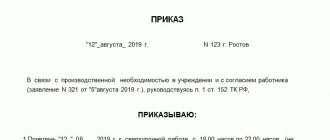Calculation of the reserve for vacation pay
Let us immediately make a reservation that there are no standards regarding the calculation of the reserve for vacation pay. You must independently choose the calculation algorithm and consolidate it in your Accounting Policy. We suggest considering 3 methods of calculation.
Method 1. Calculation from the average daily earnings of each employee
In this case, the reserve is calculated based on the average daily earnings of each company employee. At the reporting date, you need to do the following for each group of employees:
- determine how many unused vacation days currently exist (including additional paid vacation);
- calculate average daily earnings;
- calculate the amount of vacation pay, taking into account contributions to extra-budgetary funds;
- add up the amount of calculated vacation pay for all employees of the group, taking into account contributions to extra-budgetary funds.
The amount of vacation pay is calculated using the formula:
Method 2. Determining the average earnings of a group of employees
In this case, average earnings are determined not for each person individually, but in groups. The sequence of actions will be as follows:
- to begin with, the total number of unused vacation days is determined, including additional paid vacation;
- the average daily earnings are calculated for each group of workers for the reporting period;
- the amount of the reserve is determined for each group of employees using a formula;
- All sums by group are added up.
In this case, the average daily earnings are determined as follows:
The amount of the reserve in this case is determined by the following formula:
Method 3. Determining the standard for contributions to the reserve, which is calculated based on the results of the previous year
This standard will be determined as the share of expenses for vacation pay and compensation for employees of each group in the total cost of wages for this group for the year.
In this case you need:
- determine the standard for contributions to the reserve for vacation pay for a group of employees as of December 31 of the previous year;
- calculate the amount of contributions to the reserve for the group at each reporting date of the current year;
- add up the found amount of the reserve for vacation pay for all groups.
Determine the standard using the formula:
Determine the amount of deductions for the group using the formula:
If the reserve is not enough and the balance on account 96 has become zero, then vacation pay and compensation for unused vacation must be credited to the debit of cost accounting accounts 20 (08, 23, 26, 44).
Reflection of the vacation reserve in accounting
The calculation and reflection of the vacation reserve in accounting must be carried out at each reporting date. According to current legal requirements, the balance sheet is compiled once a year - that is, December 31 will be the reporting date.
However, it is more accurate and correct (primarily for management accounting) to form vacation reserves on a monthly basis, since this type of reserve depends on the number of employees and vacations taken - and these values can change very often. It should be understood that monthly reserve calculation is labor-intensive. The organization needs to independently determine the desired frequency of settlements and record it in its accounting policies.
In accounting, account 96 is intended to reflect such information. All planned costs of the company are accumulated on it, including vacation pay. In this case, a separate sub-account is opened for each type of expense.
Let's consider typical transactions for the accrual and write-off of reserves in correspondence with the account. 96:
| Account Dt | Account name | Kt account | Contents of operation |
| 08 | Fixed assets | ||
| 20 | Primary production | 96.01 “Reserve for payment of employee vacations” | A reserve for employee leave has been accrued (accounts are selected depending on the department in which the employee works) |
| 23 | Auxiliary production | ||
| 26 | General expenses | ||
| 44 | Selling expenses | ||
| Other expense accounts of the company, which account for salary expenses | |||
| 96.01 | Reserve for employee vacation pay | 70 “Labor expenses” | Vacation pay accrued at the expense of the created reserve |
| 69 “Settlements with extra-budgetary funds” | Insurance premiums accrued from the reserve | ||
As you can see, the reserve is always accrued to the same accounts as employee salaries. Insurance premiums are calculated according to the same principle, but in correspondence with the reserve account, and not with accounts for settlements with extra-budgetary funds.
The balance of account 96 when generating periodic reporting is reflected in the liability side of the balance sheet. Line 1540 “Estimated Liabilities” is intended for this purpose.
Please note: if reserves in an organization are created only in accounting, then the base for calculating income tax is not reduced, and temporary tax differences arise, in accordance with PBU 18/02. If the accounting policy for tax accounting states that this reserve is taken into account when calculating income tax, the right appears to create it in the manner specified in Art. 324.1 Tax Code of the Russian Federation.
Creating a reserve for tax purposes is a voluntary matter, depending only on the decision of the business entity.
Why is it calmer and more reliable with PROGRAMS 93 LLC than with regular employees?
- You work with a team. The work of each specialist is checked by competent specialists; you do not need to understand the issue yourself.
- Our problems don't become yours. There is no need to organize a workplace for an employee, pay him sick leave and vacations. You won’t even notice that someone from the team is sick - another specialist will immediately replace him!
- We have experts of different profiles. We take a comprehensive approach to accounting and can optimize the work of an entire department.
Call the phone number listed on the website or fill out the feedback form so that we can guide you on the exact cost, choose the best solution and tell you how to start cooperation!
Vacation reserves - working on mistakes
Many questions often arise regarding the formation of estimated obligations for vacation payments to employees. There are many errors in this part of accounting. As a rule, we are talking about serious amounts that seriously affect the financial results of the company. How to avoid mistakes in this matter? Let's find out in the article.
Until 2011, there was a rule in accounting that an organization could (but was not obligated) to create reserves to pay vacations to its employees. The essence of this “old” reserve for vacation pay was that with its help, an organization could smooth out sharp changes in the cost of paying vacation pay to its employees during the calendar year, since, as a rule, in the summer the cost of paying for vacation is much higher than in the winter.
But it is very important to understand that the “old” reserve for vacation payments at the end of each year was always reset to zero, i.e. it only worked for a year. With its help, organizations were also able to level out the monthly cost of manufactured products so that there were no surges and dips depending on the number of holidays.
PBU-8/2010 “Estimated liabilities, contingent liabilities and contingent facts” came into force in 2011. According to it, financial statements must contain not only data on the company’s documented obligations to contractors and third parties, but also information on planned expenses that are inevitable. With the compilation of this information, financial statements become more reliable, since they reflect the most realistic picture of the financial position of the enterprise.
I note that these PBU-8/2010 may not be used only by organizations that have the right to use simplified accounting methods, including simplified accounting statements (see clause 3 of PBU-8/2010). Consequently, all other organizations are required to apply these PBUs.
I would also note that the absence of this information on the accounting accounts can be regarded as a violation of the rules for accounting for income and expenses, for which liability arises on two grounds:
- for a gross violation of accounting for income and expenses in the absence of signs of a tax offense under Art. 120 of the Tax Code of the Russian Federation in the amount of 10-30 thousand rubles;
- administrative liability applied to officials under Art. 15.11 Code of Administrative Offenses of the Russian Federation.
At the same time, PBU-8/2010 solves this issue completely differently, although it talks about the same problem - how to take into account planned expenses that have not yet been documented, but are de jure inevitable. First of all, this category of expenses includes vacation pay to employees. Notice the difference: PBU-8/2010 speaks of the need to form an estimated liability of an organization to be reflected in the financial statements in order to fully show in it all, without exception, obligations formed as of the reporting date.
And obligations to pay vacations to its employees are de jure formed by any organization every day. Because every day an employee works gives him the right to a piece of vacation, which in the future must be paid by the employer.
And of course, the company’s obligations to pay for vacations can be calculated in monetary terms. These obligations are calculated and formed (i.e., taken into account in the accounting accounts) one-time as of the reporting date. In addition, such vacation pay obligations must also be increased by the amount of insurance contributions to social funds.
Our estimated liabilities are reflected in accounting in rubles by posting:
Debit 20, 26, 44, 69 Credit 96 “ Reserves ... for vacation payments.”
"reserve" appears currently (post-2011) . It is only in the title of accounting account number 96. But in fact, this is not a reserve, but a pure estimated liability formed according to the rules of PBU-8/2010.
And at the moment when employees go on vacation, vacation pay is accrued to them at the expense of this previously formed estimated liability and is reflected in accounting entries:
Debit 96 Credit 70.69
Thus, in the future, this estimated liability works (is used) by the company in a similar way to the previous reserve for vacation payments, which existed before 2011, but as a kind of financial source intended to finance actual vacations for employees.
How it works? The amounts of the estimated liability formed at the end of last year for the payment of vacations already earned by employees at the end of last year make it possible not to include vacation payments actually accrued and paid in the current month in the cost price of the current month. Since these amounts were included in the company’s costs earlier, in the period when these vacation days actually arose and formed as a liability of the company.
If the valuation reserve was not enough to pay actual vacation pay, then in the future these payments are already included in the cost of the current period. At the same time, during the current year, employees again earn vacation days, which also need to be calculated and thus adjust this estimated liability for the next reporting date.
In conclusion, I note that only by such actions (and no other way) is an accurate and complete reflection in the accounting of the company’s actual costs (expenses) for the production of products (works, services) achieved and at the same time, an accurate and complete reflection in the accounting of all, without exception, actually formed obligations companies (including to employees regarding the payment of vacations to them) arising in connection with the company’s economic activities. If this is not done, then problems are guaranteed to arise with confirming the reliability of the financial statements through their audit.
What to do if the amount of the obligation before the end of the year turns out to be less than the cost of paying for vacations
As we have already said, the amount of vacation obligations can only be calculated approximately. Therefore, in practice, it is likely that by the end of the year you will spend more on paying for vacations than you planned. In this case, it is enough to include the difference in current expenses. That is, make a posting for the amount of the difference:
DEBIT 20 (23, 25, 26, 29, 44) CREDIT 70 - vacation pay is accrued if the actual expenses for paying for vacations exceed the reserve amount.
Example 2. The amount of the obligation turned out to be less than the actual costs of paying for vacations
An employee of Mir CJSC M.A. Sedova goes on vacation from December 27, 2012 for 14 calendar days. She was granted unscheduled leave in agreement with management.
Let's assume that the amount of vacation pay was 56,000 rubles. The company creates an estimated liability in accounting for upcoming vacation payments.
However, at the time of accrual of vacation pay, the reserve amount was already completely exhausted. Therefore, the company accountant made the following entry:
DEBIT 44 CREDIT 70 - 56,000 rub. — Sedova’s vacation pay was accrued.
It turns out that at the end of the year you don’t have a penny left in your vacation reserve. This means that with a posting dated December 31, reflect the creation of a new estimated liability based on how many days of legal rest your employees are entitled to at the end of 2012.








